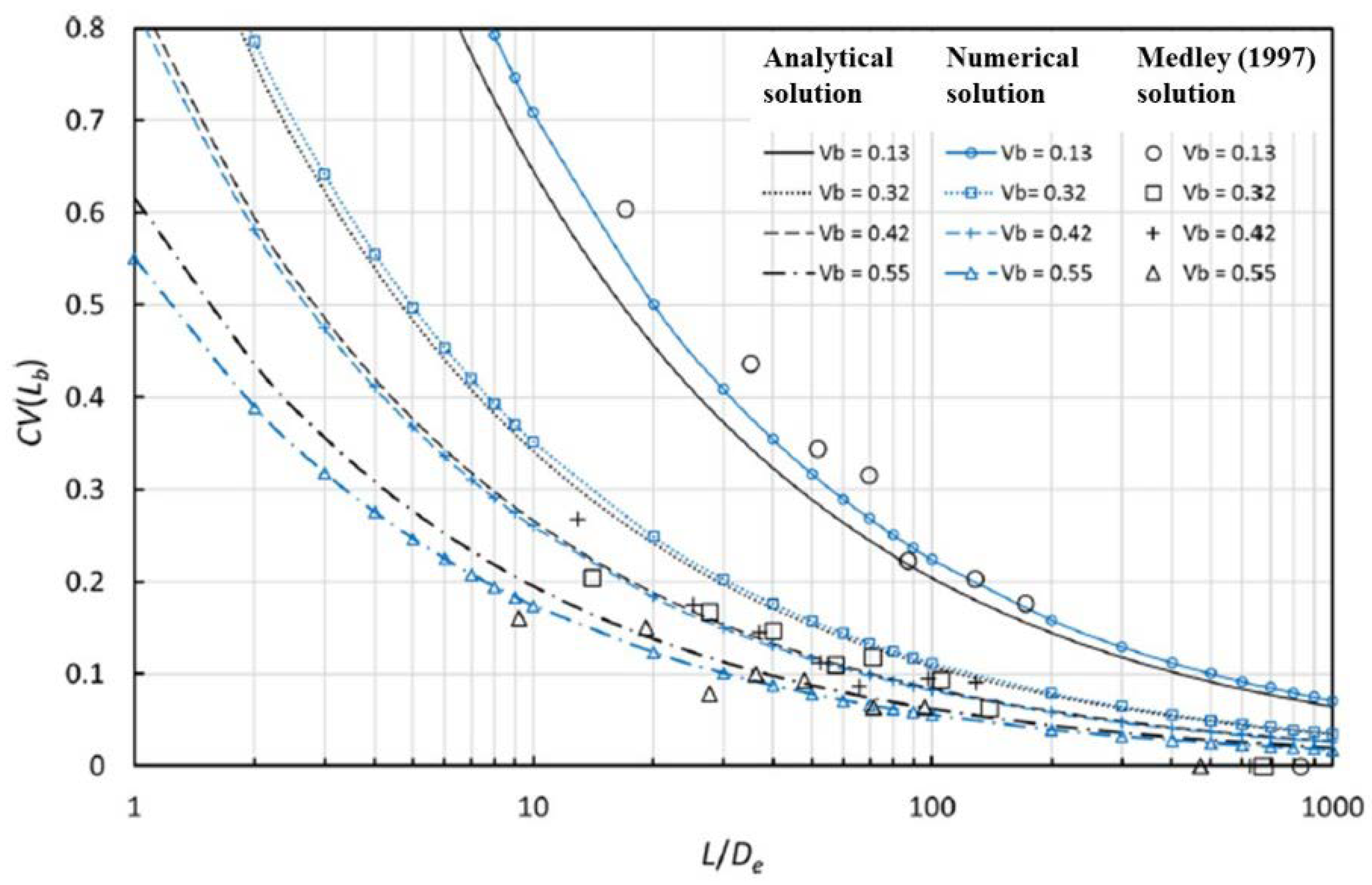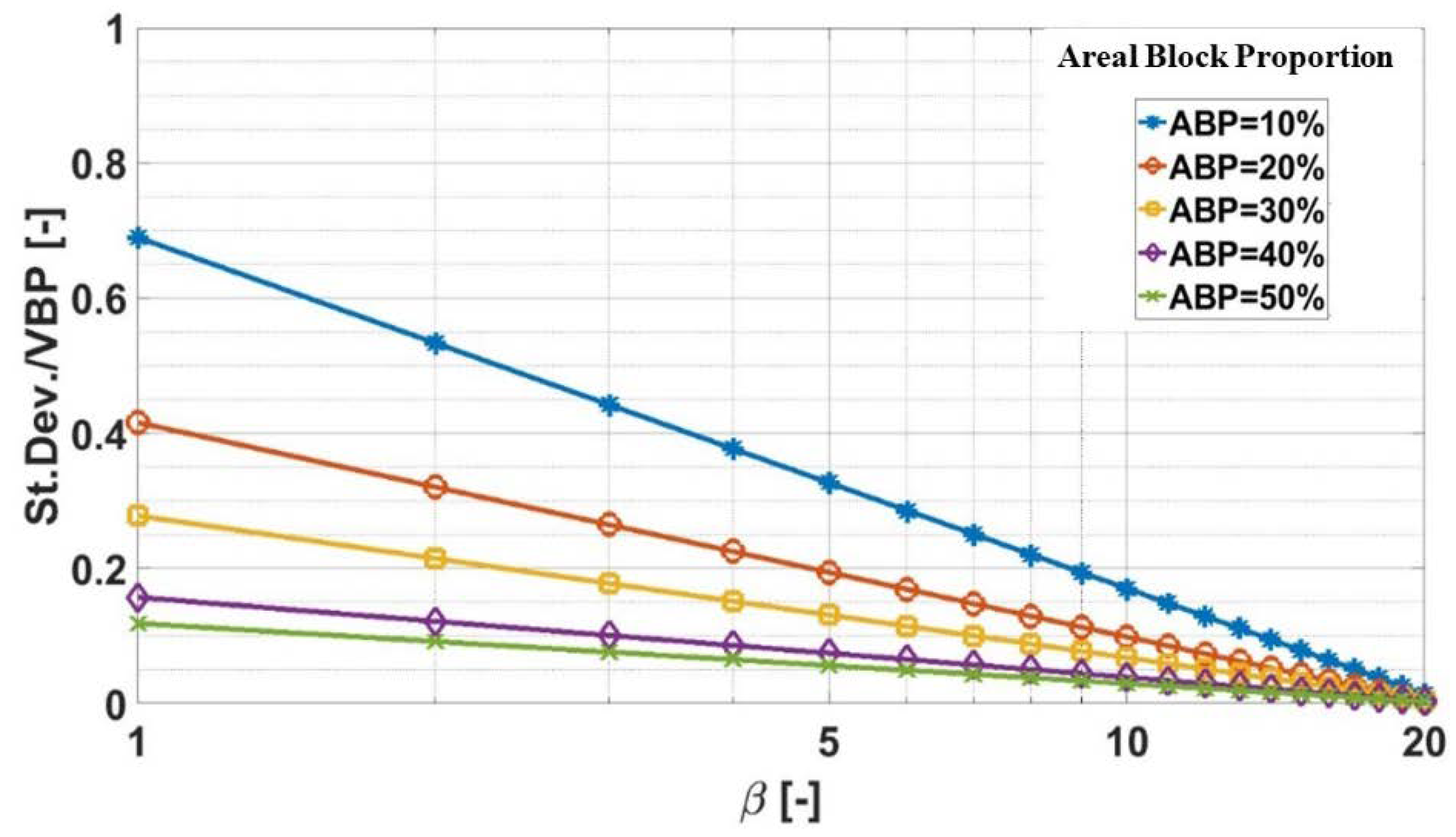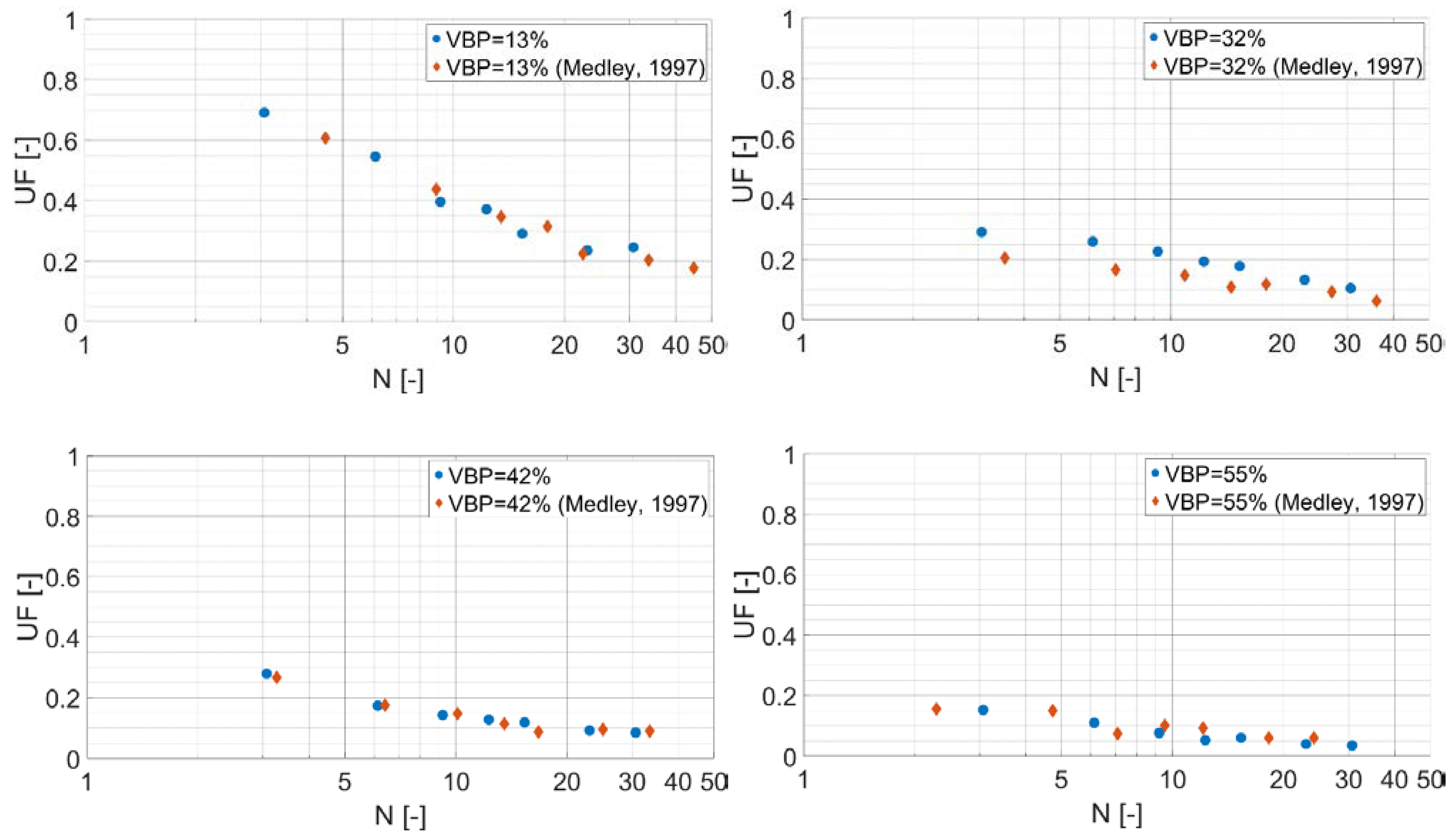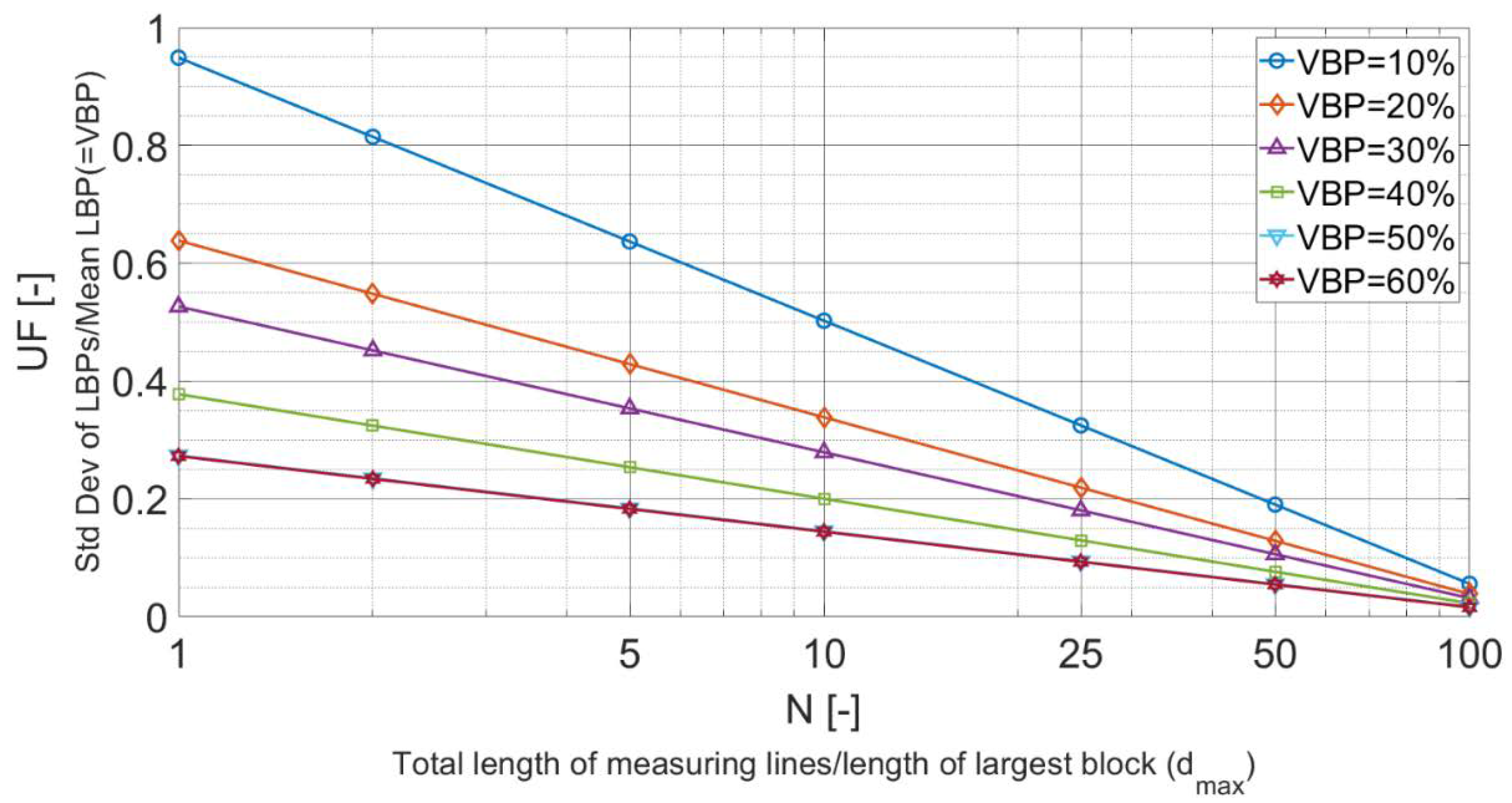Investigation of Virtual Bimrocks to Estimate 3D Volumetric Block Proportions from 1D Boring Measurements
Abstract
:1. Introduction
- 2D measurements (areal block proportions, ABPs), which can be obtained by examining geological maps, mapping outcrops or photographs and/or by using digital image analyses. Specifically, the ABP can be determined as the ratio between the area of all blocks measured in a sample area and the sample area analyzed [1,3,27,36,37,38,39];
- 1D measurements (linear block proportions, LBPs), which can be obtained by analyzing exploration drilling or linear sampling traverses (scanlines) on outcrops/photographs. Specifically, the LBP can be determined from the proportion of total intercept lengths of blocks penetrated by drill cores (or scanlines) to the total length of drilling [1,2,40,41,42,43,44,45];
- 0D measurements (node or point block proportions, PBPs), which consists of the node (or point) counting technique. This is a common method in several research fields (including geology, biology and materials science) to allow the proportion of an area covered by some objects of interest to be easily determined. Specifically, a grid is i {\displaystyle i} superimposed over an image, the intersection points are counted and then divided by the total number of the points of the grid (Medley, 1994).
Uncertainties in VBP Estimates: An Overview
2. Uncertainty in VBP Estimates from LBPs
2.1. Validation of Medley’s 1997 Findings
2.2. Extension of Medley’s 1997 Findings
2.3. Effects of Increasing the 3D Domain Size
- The use of a larger domain allowed an increased total number of simulated boreholes (ϑ) to be analyzed and avoided short boring spacings, which would have made the LBPs of two neighboring boreholes almost identical. Hence, the increased geometry allowed for larger virtual boring spacing and more variable datasets of results to be analyzed;
- With higher ϑ values (total number of scanlines analyzed), it was possible to consider more varied borehole location distributions by adopting a greater number of randomizations (λ) for each sub-set of combined scanlines (β);
- A higher ϑ allowed the values of β considered in the analyses to be increased, to obtain results for values of N higher than 45. It is emphasized that although the value of the UF can be determined from Figure 2b [49] for values of N (Ndmax) up to 100, in actuality, Medley [49] extrapolated the line trends in the interval (2, 25–45) rightwards for N of 45 (i.e., in the interval 25–45, 100). Therefore, the region of the Medley [49] graph beyond Ndmax~45 likely reports suspect uncertainty factors.
3. Application Example: VBP of the Mélange in Foundation of Scott Dam, California
4. Results and Discussion
Author Contributions
Funding
Data Availability Statement
Conflicts of Interest
References
- Medley, E.W. The Engineering Characterization of Melanges and Similar Block-in-Matrix Rocks (Bimrocks). Ph.D. Thesis, University of California, Berkeley, CA, USA, 1994. [Google Scholar]
- Medley, E.W. Orderly Characterization of Chaotic Franciscan Melanges. Felsbau 2001, 19, 20–33. [Google Scholar]
- Haneberg, W.C. Simulation of 3D Block Populations to Charaterize Outcrop Sampling Bias in Bimrocks. Felsbau 2004, 22, 19–26. [Google Scholar]
- Napoli, M.L.; Milan, L.; Barbero, M.; Scavia, C. Identifying Uncertainty in Estimates of Bimrocks Volumetric Proportions from 2D Measurements. Eng. Geol. 2020, 278, 105831. [Google Scholar] [CrossRef]
- Hunt, S.W.; Del Nero, D.E. Two Decades of Advances Investigating, Baselining and Tunneling in Bouldery Ground. In Proceedings of the World Tunneling Congress, Vancouver, BC, Canada, 14–20 May 2010; pp. 1–8. [Google Scholar]
- Ramos-Cañón, A.M.; Castro-Malaver, L.C.; Padilla-Bello, N.V.; Vega-Posada, C.A. Incertidumbre En La Determinación Del Porcentaje Volumétrico de Bloques de BIMrocks/BIMsoil a Partir de Información Unidimensional. Rev. Boletín Geol. 2020, 42, 69–80. [Google Scholar] [CrossRef] [Green Version]
- Medley, E.W.; Goodman, R.E. Estimating the Block Volumetric Proportions of Melanges and Similar Block-in-Matrix Rocks (Bimrocks). In Proceedings of the 1st North American Rock Mechanics Symposium, Austin, TX, USA, 1–3 June 1994; pp. 851–858. [Google Scholar]
- Kahraman, S.; Alber, M. Estimating Unconfined Compressive Strength and Elastic Modulus of a Fault Breccia Mixture of Weak Blocks and Strong Matrix. Int. J. Rock Mech. Min. Sci. 2006, 43, 1277–1287. [Google Scholar] [CrossRef]
- Kalender, A.; Sonmez, H.; Medley, E.; Tunusluoglu, C.; Kasapoglu, K.E. An Approach to Predicting the Overall Strengths of Unwelded Bimrocks and Bimsoils. Eng. Geol. 2014, 183, 65–79. [Google Scholar] [CrossRef]
- Khorasani, E.; Amini, M.; Hossaini, M.F.; Medley, E.W. Statistical Analysis of Bimslope Stability Using Physical and Numerical Models. Eng. Geol. 2019, 254, 13–24. [Google Scholar] [CrossRef]
- Medley, E.W.; Sanz Rehermann, P.F. Characterization of Bimrocks (Rock/Soil Mixtures) With Application to Slope Stability Problems. In Proceedings of the Eurock 2004 & 53rd Geomechanics Colloquium, Salzburg, Austria, 7–9 October 2004. [Google Scholar]
- Medley, E.W.; Zekkos, D. Geopractitioner Approaches to Working with Antisocial Mélanges. In Mélanges: Processes of Formation and Societal Significance—Geological Society of America Special Paper 480; Wakabayashi, J., Dilek, Y., Eds.; Geological Society of America: Boulder, CO, USA, 2011; Volume 42, pp. 261–277. ISBN 9780123742919. [Google Scholar]
- Napoli, M.L.; Barbero, M.; Scavia, C. Slope Stability in Heterogeneous Rock Masses with a Block-in-Matrix Fabric. In Rock Mechanics for Natural Resources and Infrastructure Development, Proceedings of the 14th International Congress on Rock Mechanics and Rock Engineering, ISRM, Foz do Iguassu, Brazil, 13–18 September 2019; CRC Press: Boca Raton, FL, USA, 2019; pp. 3482–3489. [Google Scholar]
- Sonmez, H.; Gokceoglu, C.; Tuncay, E.; Medley, E.W.; Nefeslioglu, H.A. Relationships between Volumetric Block Proportions and Overall UCS of a Volcanic Bimrock. Felsbau Rock Soil Eng. J. Eng. Geol. Geomech. Tunn. 2004, 22, 27–34. [Google Scholar]
- Napoli, M.L.; Barbero, M.; Ravera, E.; Scavia, C. A Stochastic Approach to Slope Stability Analysis in Bimrocks. Int. J. Rock Mech. Min. Sci. 2018, 101, 41–49. [Google Scholar] [CrossRef]
- Barbero, M.; Bonini, M.; Borri-Brunetto, M. Numerical Simulations of Compressive Tests on Bimrock. Electron. J. Geotech. Eng. 2012, 17X, 3397–3414. [Google Scholar]
- Napoli, M.L. 3D Slope Stability Analyses of a Complex Formation with a Block-in-Matrix Fabric. In Lecture Notes in Civil Engineering, Proceedings of the Challenges and Innovations in Geomechanics, IACMAG 2021, Turin, Italy, 5–8 May 2021; Springer: Turin, Italy, 2021; Volume 126, p. 7. [Google Scholar]
- Xu, W.; Xu, Q.; Hu, R. Study on the Shear Strength of Soil-Rock Mixture by Large Scale Direct Shear Test. Int. J. Rock Mech. Min. Sci. 2011, 48, 1235–1247. [Google Scholar] [CrossRef]
- Zhang, H.; Hu, X.; Boldini, D.; He, C.; Liu, C.; Ai, C. Evaluation of the Shear Strength Parameters of a Compacted S-RM Fill Using Improved 2-D and 3-D Limit Equilibrium Methods. Eng. Geol. 2020, 269, 105550. [Google Scholar] [CrossRef]
- Zhang, H.; Boldini, D.; Wang, L.; Deng, H.; Liu, C. Influence of Block Form on the Shear Behaviour of Soft Soil–Rock Mixtures by 3D Block Modelling Approaches. Rock Mech. Rock Eng. 2022, 55, 3279–3300. [Google Scholar] [CrossRef]
- Huang, X.; Wei, Y.; Ai, W.; Jiang, P. Stability Analysis of Soil - Rock Slope ( SRS ) with an Improved Stochastic Method and Physical Models. Environ. Earth Sci. 2021, 80, 649. [Google Scholar] [CrossRef]
- Kahraman, S.; Alber, M.; Fener, M.; Gunaydin, O. Evaluating the Geomechanical Properties of Misis Fault Breccia (Turkey). Int. J. Rock Mech. Min. Sci. 2008, 45, 1469–1479. [Google Scholar] [CrossRef]
- Li, Y.; Huang, R.; Chan, L.S.; Chen, J. Effects of Particle Shape on Shear Strength of Clay-Gravel Mixture. KSCE J. Civ. Eng. 2013, 17, 712–717. [Google Scholar] [CrossRef]
- Lindquist, E.S. The Mechanical Properties of a Physical Model Melange. In Proceedings of the 7th International IAEG Congress, Austin, TX, USA, 1–3 June 1994; pp. 819–826. [Google Scholar]
- Schmüdderich, C.; Prada-Sarmiento, L.F.; Wichtmann, T. Numerical Analyses of the 2D Bearing Capacity of Block-in-Matrix Soils (Bimsoils) under Shallow Foundations. Comput. Geotech. 2021, 136, 104232. [Google Scholar] [CrossRef]
- Wang, S.; Li, Y.; Gao, X.; Xue, Q.; Zhang, P.; Wu, Z. Influence of Volumetric Block Proportion on Mechanical Properties of Virtual Soil-Rock Mixtures. Eng. Geol. 2020, 278, 105850. [Google Scholar] [CrossRef]
- Zhang, S.; Tang, H.; Zhan, H.; Lei, G.; Cheng, H. Investigation of Scale Effect of Numerical Unconfined Compression Strengths of Virtual Colluvial-Deluvial Soil-Rock Mixture. Int. J. Rock Mech. Min. Sci. 2015, 77, 208–219. [Google Scholar] [CrossRef]
- Napoli, M.L.; Barbero, M.; Scavia, C. Geomechanical Characterization of an Italian Complex Formation with a Block-in-Matrix Fabric. In Theory to Practice (EUROCK 2021), Proceedings of the Mechanics and Rock Engineering, Torino, Italy, 20–25 September 2021; IOP Science: Bristol, UK, 2021; p. 8. [Google Scholar]
- DiPonio, M.A.; Chapman, D.; Bournes, C. EPB Tunnel Boring Machine Design for Boulder Conditions. In Proceedings of the Rapid Excavation and Tunneling Conference, Toronto, ON, Canada, 11–13 June 2007; pp. 215–228. [Google Scholar]
- Gwildis, U.; Aguilar, J.; Mosavat, K. TBM Tool Wear Analysis for Cutterhead Configuration and Resource Planning in Glacial Geology. In Proceedings of the North American Tunneling Conference, Washington, DC, USA, 24–27 June 2018. [Google Scholar]
- Hunt, S.W. Tunneling in Cobbles and Boulders. In Proceedings of the 10th Annual Breakthroughs in Tunneling Short Course, Chicago, IL, USA, 14–16 August 2017; pp. 1–46. [Google Scholar]
- Napoli, M.L.; Barbero, M.; Scavia, C. Tunneling in Heterogeneous Rock Masses with a Block-in-Matrix Fabric. Int. J. Rock Mech. Min. Sci. 2021, 138, 11. [Google Scholar] [CrossRef]
- Lindquist, E.S. The Strength and Deformation Properties of Melange. Ph.D. Thesis, University of California, Berkeley, CA, USA, 1994. [Google Scholar]
- Russ, J.C.; Dehoff, R.T. Practical Stereology; Springer: Berlin/Heidelberg, Germany, 2000; ISBN 9781461354536. [Google Scholar]
- Sahagian, D.L.; Proussevitch, A.A. 3D Particle Size Distributions from 2D Observations: Stereology for Natural Applications. J. Volcanol. Geotherm. Res. 1998, 84, 173–196. [Google Scholar] [CrossRef]
- Coli, N.; Berry, P.; Boldini, D.; Bruno, R. The Contribution of Geostatistics to the Characterisation of Some Bimrock Properties. Eng. Geol. 2012, 137–138, 53–63. [Google Scholar] [CrossRef]
- Fagereng, Å. Frequency-Size Distribution of Competent Lenses in a Block-in-Matrix Mélange: Imposed Length Scales of Brittle Deformation? J. Geophys. Res. 2011, 116, 1–12. [Google Scholar] [CrossRef]
- Kahraman, S.; Alber, M.; Fener, M.; Gunaydin, O. An Assessment on the Indirect Determination of the Volumetric Block Proportion of Misis Fault Breccia (Adana, Turkey). Bull. Eng. Geol. Environ. 2015, 74, 899–907. [Google Scholar] [CrossRef]
- Sonmez, H.; Tuncay, E.; Gokceoglu, C. Models to Predict the Uniaxial Compressive Strength and the Modulus of Elasticity for Ankara Agglomerate. Int. J. Rock Mech. Min. Sci. 2004, 41, 717–729. [Google Scholar] [CrossRef]
- Goodman, R.E.; Ahlgren, C.S. Evaluating Safety of Concrete Gravity Dam on Weak Rock: Scott Dam. J. Geotech. Geoenviron. Eng. 2000, 126, 429–442. [Google Scholar] [CrossRef]
- Medley, E.W. Bimrocks—Part 2: Case Histories and Practical Guidelines; Newsletter of the Hellenic Society of Soil Mechanics and Geotechnical Engineering 2007; Hellenic Society of Soil Mechanics and Geotechnical Engineering: Athens, Greece, 2007; pp. 26–31. [Google Scholar]
- Minuto, D.; Morandi, L. Geotechnical Characterization and Slope Stability of a Relict Landslide in Bimsoils (Blocks in Matrix Soils) in Dowtown Genoa, Italy. Eng. Geol. Soc. Territ. Landslide Process. 2015, 2, 1083–1088. [Google Scholar] [CrossRef] [Green Version]
- Medley, E.W. Uncertainty in Estimates of Block Volumetric Proportions in Melange Bimrocks. In Proceedings of the International Symposium on Engineering Geology and the Environmental, Athens, Greece, 23–27 June1997; pp. 267–272. [Google Scholar]
- Sonmez, H.; Altinsoy, H.; Gokceoglu, C.; Medley, E.W. Considerations in Developing an Empirical Strength Criterion for Bimrocks. In Proceedings of the 4th Asian Rock Mechanics Symposium (ARMS 2006), Singapore, 6–10 November 2006; p. 7. [Google Scholar]
- Lu, Y.C.; Tien, Y.M.; Juang, C.H.; Lin, J.S. Uncertainty of Volume Fraction in Bimrock Using the Scan-Line Method and Its Application in the Estimation of Deformability Parameters. Bull. Eng. Geol. Environ. 2020, 79, 1651–1668. [Google Scholar] [CrossRef] [Green Version]
- Underwood, E.E. Quantitative Stereology, 2nd ed.; Addison-Wesley Publ. Company: Reading, MA, USA, 1970; p. 272. [Google Scholar]
- Weibel, E.R. Stereological Methods: Theoretical Foundations; Academic Press: New York, NY, USA, 1980; Volume 2. [Google Scholar]
- Tien, Y.M.; Lin, J.-S.; Kou, M.C.; Lu, Y.C.; Chung, Y.J.; Wu, T.H.; Lee, D.H. Uncertainty in Estimation of Volumetric Block Proportion of Bimrocks by Using Scanline Method. In Proceedings of the 44th U.S. Rock Mechanics Symposium and 5th U.S.-Canada Rock Mechanics Symposium, Salt Lake City, UT, USA, 27–30 June 2010. [Google Scholar]
- Medley, E.W. Systematic Characterization of Melange Bimrocks and Other Chaotic Soil/Rock Mixtures. Felsbau 1999, 17, 152–162. [Google Scholar]
- Medley, E.W. Estimating Block Size Distributions of Melanges and Similar Block-in-Matrix Rocks (Bimrocks). In Proceedings of the 5th North American Rock Mechanics Symposium (NARMS), Toronto, ON, Canada, 7–10 July 2002; pp. 509–606. [Google Scholar]
- Medley, E.W.; Lindquist, E.S. The Engineering Significance of the Scale-Independence of Some Franciscan Melanges in California, USA. In Proceedings of the 35th U.S. Symposium on Rock Mechanics (USRMS), Reno, NV, USA, 5–7 June 1995; pp. 907–914. [Google Scholar]
- Khorasani, E.; Amini, M.; Hossaini, M.; Medley, E. Evaluating the Effects of the Inclinations of Rock Blocks on the Stability of Bimrock Slopes. Geomech. Eng. 2019, 17, 281–287. [Google Scholar] [CrossRef]
- Wang, X.; Yin, Z.Y.; Su, D.; Wu, X.; Zhao, J. A Novel Approach of Random Packing Generation of Complex-Shaped 3D Particles with Controllable Sizes and Shapes. Acta Geotech. 2022, 17, 355–376. [Google Scholar] [CrossRef]










| VBP [%] | Fitting Equation | c1 [-] | c2 [-] | R2 [-] |
|---|---|---|---|---|
| 10 | UF = −c1∙ln(N) + c2 | 0.1940 | 0.9491 | 0.925 |
| 20 | 0.1303 | 0.6386 | 0.926 | |
| 30 | 0.1075 | 0.5266 | 0.927 | |
| 40 | 0.0771 | 0.3777 | 0.928 | |
| 50 | 0.0558 | 0.2735 | 0.925 | |
| 60 | 0.0558 | 0.2726 | 0.923 |
Publisher’s Note: MDPI stays neutral with regard to jurisdictional claims in published maps and institutional affiliations. |
© 2022 by the authors. Licensee MDPI, Basel, Switzerland. This article is an open access article distributed under the terms and conditions of the Creative Commons Attribution (CC BY) license (https://creativecommons.org/licenses/by/4.0/).
Share and Cite
Napoli, M.L.; Milan, L.; Barbero, M.; Medley, E. Investigation of Virtual Bimrocks to Estimate 3D Volumetric Block Proportions from 1D Boring Measurements. Geosciences 2022, 12, 405. https://doi.org/10.3390/geosciences12110405
Napoli ML, Milan L, Barbero M, Medley E. Investigation of Virtual Bimrocks to Estimate 3D Volumetric Block Proportions from 1D Boring Measurements. Geosciences. 2022; 12(11):405. https://doi.org/10.3390/geosciences12110405
Chicago/Turabian StyleNapoli, Maria Lia, Lorenzo Milan, Monica Barbero, and Edmund Medley. 2022. "Investigation of Virtual Bimrocks to Estimate 3D Volumetric Block Proportions from 1D Boring Measurements" Geosciences 12, no. 11: 405. https://doi.org/10.3390/geosciences12110405
APA StyleNapoli, M. L., Milan, L., Barbero, M., & Medley, E. (2022). Investigation of Virtual Bimrocks to Estimate 3D Volumetric Block Proportions from 1D Boring Measurements. Geosciences, 12(11), 405. https://doi.org/10.3390/geosciences12110405








